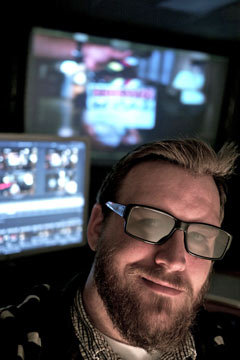Paradise FX's Joe VanDalsem on the Remote Digital Lab for Dolphin Tale


Above: Joe VanDalsem. All images provided by Iridas
Film & Video: I understand you have the ability to look at dailies in 3D, instantly, on set. How does that work?
Joe VanDalsem: We’re more “on location” than “on set.” We’re set up at the production office. We do have the ability to view the footage as soon as we transfer the files into the system. There’s no real rendering time, and if we were to move on set we could do the same thing. The DIT takes on the role of what a [film] loader would typically be doing. He gathers all the footage onto a mirrored RAID hard drive. We break twice a day, once at lunch and once at the end of the day, and that drive is shuttled to us [at those breaks]. Within about an hour of the break, we get the footage, ingest it and start looking at it in 3D, checking for quality and processing it out for editorial, doing grades and color and all that stuff.
What are the components of your system?
It’s really a remote digital lab. We’re using Iridas Speedgrade as our main program for playing back the footage and checking it for quality. We’re playing back to an 11-foot screen through an LG CF3D LCoS projector. It’s a nice projector – pretty pricey, but with a nice image.
Are you looking specifically for issues with the depth effects?
Mostly, yeah. Just like focus, the stereographer has got to be on the ball as far as getting the depth where it should be for a shot. Occasionally, if it’s not exactly right, we can catch it and make adjustments and send that on to editorial so when they’re editing in 3D they can avoid seeing those uncomfortable moments. We’ve already fixed them. We’re just using the stereo tools in Speedgrade to do that.
We’re also playing everything back on a daily basis. After they wrap, they come into the production office and start watching the entire day’s worth of dailies. We do the previous day at the end of the next day, but we do have the capability of seeing them more quickly. A lot of times we’re viewing the first half of the day at the end of that day while the second half of the day is being transferred.
Occasionally. Not so much on this show, but I’ve seen it in the past. A shot could be way off, 3D-wise, or have some other problem. Maybe there’s an exposure difference or a focus difference between eyes. We have caught some problems very quickly. With RED footage, occasionally when you’re transferring off of the card, frames can become corrupt. Because we’re looking at everything within an hour, we know that before we re-use that CF card, we can tell if there’s a corrupted file. That’s happened probably three or four times on this show. We’ve caught corrupted files that otherwise would have gone through the pipeline without anyone knowing. We caught them before they re-used those CF cards, so we were able to pull that file again and recover that corrupted frame. We’ve set it up so that we have two full days’ worth of card stock on hand [for that reason].
When you say it’s a corrupted frame, you mean it was corrupted in the transfer process [from the compact flash card]. It’s not a frame that’s lost completely.
You can get [corruption] when you’re transferring off the camera and onto the card. We haven’t seen that yet. But it can also happen during transfer from the card to the hard drive. It’s really necessary to check everything as quickly as possible to make sure you don’t have any of those problems.
So obviously you’re not looking at just 3D and depth effects.
We’re looking at the whole spectrum of things. The 3D on this show has been very comfortable, but we’ll look for alignment problems, vertical shifts, or sometimes the motors can glitch on a particular shot. You’ll be looking at it and suddenly one eye zooms quickly or shifts laterally quickly for a couple of frames. It’s caused by radio frequency interference. If and when it happens, we catch it and call the set and they can come in and look at it and decide what to do.
Sections: Creativity Technology
Topics: Project/Case study
Did you enjoy this article? Sign up to receive the StudioDaily Fix eletter containing the latest stories, including news, videos, interviews, reviews and more.
Leave a Reply